- Home
- About Us
- Industry
- Services
- Reading
- Contact Us
Aviation Interference Cancellation Market: Current Analysis and Forecast (2024-2032)
Emphasis on Type of Signal Canceller (Analogue); By Aircraft Type (Commercial (Commercial Jets, Cargo Jets and Helicopter), Military (Fighter Jets, Cargo jets and Helicopter); and Regions (North America (The US, Canada, Rest of North America), Europe (Germany, The UK, France, Russia, Rest of the Europe), Asia-pacific (China, Japan, India, Rest of the Asia-pacific), Rest of the World)
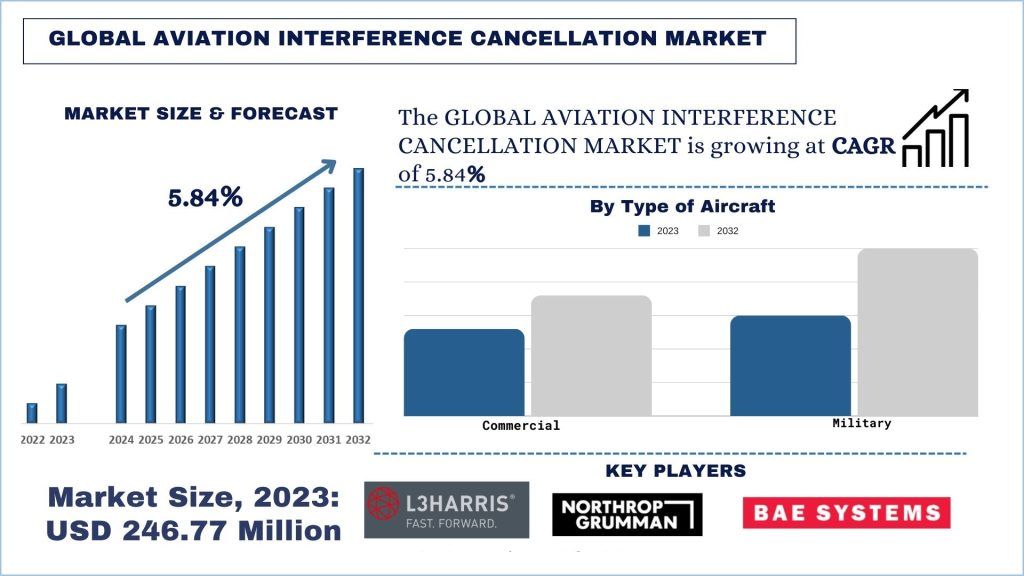 Global Aviation Interference Cancellation Market Size & Forecast
Global Aviation Interference Cancellation Market Size & Forecast
The Global Aviation Interference Cancellation market was valued at USD 246.77 million in 2023 and is expected to grow at a strong CAGR of around 5.84% during the forecast period (2024-2032) owing to rising demand for commercial and next-generation military jets across the globe.
Global Aviation Interference Cancellation Market Analysis
Aviation Interference Cancellations are adaptive filters that are used to suppress the noise or interference of signals emitted from enemy devices that intend to jam the necessary signal communication. These interference cancellation devices segregate the additional noise added in the required signals on similar frequencies and reduce the chances of communication being jammed in aircraft.
The Global Aviation Interference Cancellation market was valued at USD 246.77 million in 2023 and is expected to grow at a strong CAGR of around 5.84% during the forecast period (2024-2032). One of the factors that have contributed to the market growth is the rising demand for AWACS and dedicated electronic attack aircraft. These aircraft not only offer long-range detection but also offer robust communication jamming and interference cancellation capabilities. Jamming communication completely blocks the situation awareness of an aircraft, which is why militaries across the globe are looking forward to opting for aircraft with robust communication protection systems/interference cancellation capabilities.
The aircraft could face multiple issues that can affect radio communication, such as electromagnetic interference in avionics systems, engine noise, and external environmental factors. The interference cancellation equipment offers robust protection against unwanted interference, allowing for clear and reliable communication. The demand for interference cancellation systems has grown significantly in recent years owing to the rising sales of commercial and military aircraft orders. For instance,
In 2023, the Defense Acquisition Council of India announced the purchase of 97 additional Tejas fighter jets and 156 Prachand attack helicopters. Both aircraft are domestically produced in India and would cost approximately USD 13 billion.
In January 2024, the government of France announced the purchase of an additional 42 upgraded Rafale Jets with a total cost of USD 5.5 billion. The respective aircraft will be delivered between 2027 to 2032.
Global Aviation Interference Cancellation Market Trends
This section discusses the key market trends that are influencing the various segments of the Global Aviation Interference Cancellation Market as identified by our team of research experts.
Integration of Full-Duplex Communication Systems
There is a high demand for higher frequency efficiency and systems that transmit and receive signals simultaneously. As a full duplex communication system constantly sends and receives signals, a key challenge related to signal duplication emerged that has led to the integration of an effective self-interference cancellation system. The self-interference cancellation technology both the sampled reference self-interference signal and the received signal of the receiver are down converted to digital signals by using the Analogue to Digital Converter (ADC) and the down converter. Considering the higher adoption of duplex communication systems in commercial and military aircraft the usage of full-duplex communication using aviation interference cancellation would be a key trend in the coming period.
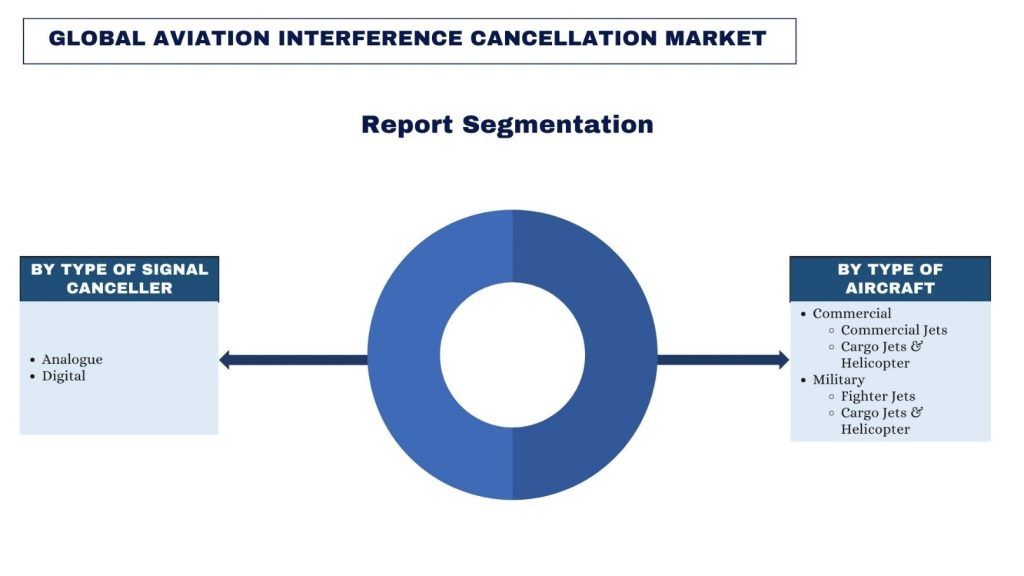
North America is Expected to Hold Major Market Share During Forecast Period
North America has one of the largest established commercial and military aircraft manufacturing units. With the presence of companies such as Boeing, Lockheed Martin, and Northrop Grumman. Additionally, the countries in the North American region, such as the US and Canada, also have a high demand for military aircraft due to their sizeable air fleet and exports. Additionally, many of the announcements have further been made for the induction of large-scale new aircraft which would further promulgate the aviation interference cancellation demand in the region. In 2024, a contract of USD 13 billion was signed with Sierra Nevada Corp to develop a successor of the E-4B aircraft (Doomsday Aircraft) by the US Air Force.
In another instance, in 2023, the US Air Force demanded the acquisition of 72 new fighter jets from the US government. The new demand is in addition to the old request for 33 new F-35As and 24 F-15EXs—57 in all.
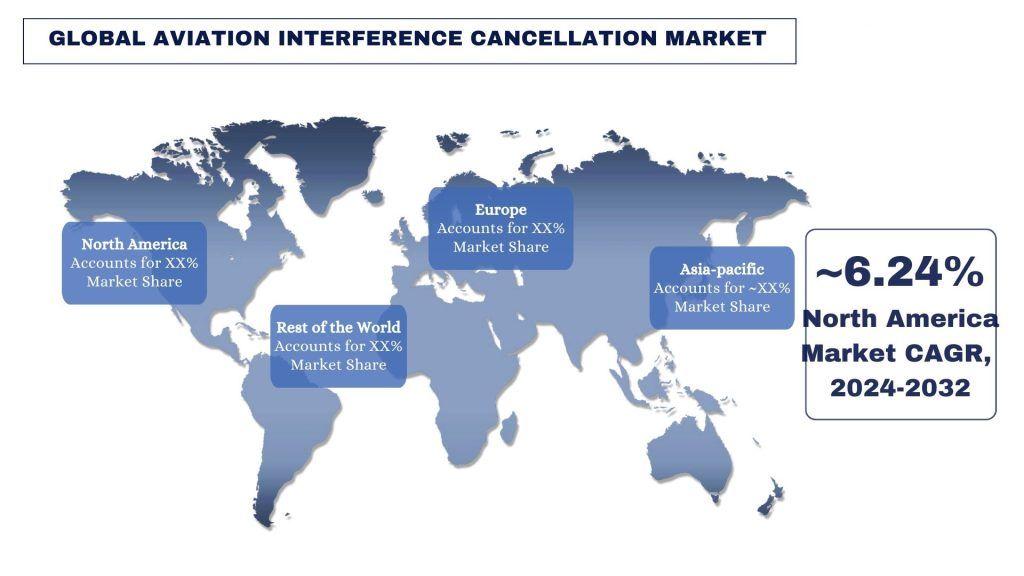
Global Aviation Interference Cancellation Industry Overview
The Global Aviation Interference Cancellation market is competitive and fragmented, with the presence of several global and international market players. The key players are adopting different growth strategies to enhance their market presence, such as partnerships, agreements, collaborations, new product launches, geographical expansions, and mergers and acquisitions. Some of the major players operating in the market are Northrop Grumman Corporation, ITT Inc., BAE Systems, Thales Group, L3harris Technologies, Cobham Defense Communication, Collins Aerospace, Kumu Networks, MagiQ Technologies, Inc., and Honeywell.
Global Aviation Interference Cancellation Market News
- In 2024, Taiwan’s Eva Airways Corp announced the purchase of 33 new Airbus A320 aircraft with a total cost of USD 10.1 billion. According to the company, the purchase would significantly reduce carbon emission and would cater to its sustainability goals.
- In 2024, Lockheed Martin stated that the government of Israel announced the purchase of a third squadron of F35 aircraft with a total cost of USD 3 billion.
- In 2024, the United Kingdom reiterated its plans to procure 138 F-35B aircraft from the US. The procurement of aircraft is in line with the growing need to improve air superiority amid the looming security threat in the European region.
Global Aviation Interference Cancellation Market Report Coverage
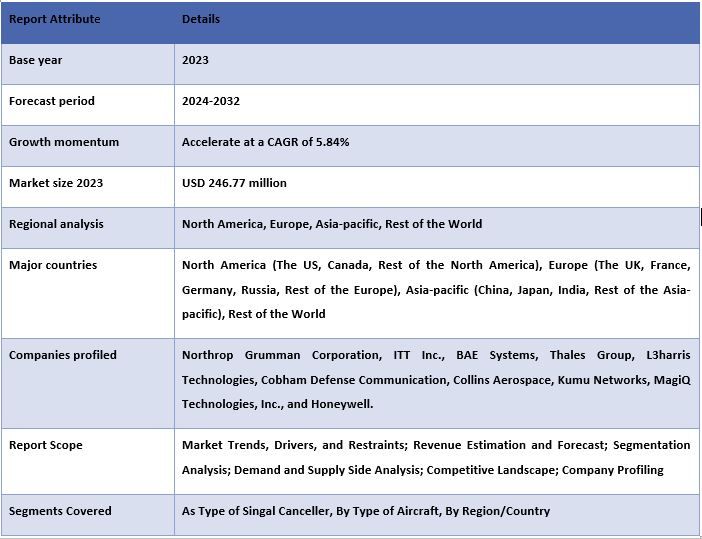
Reasons to buy this report:
- The study includes market sizing and forecasting analysis validated by authenticated key industry experts.
- The report presents a quick review of overall industry performance at one glance.
- The report covers an in-depth analysis of prominent industry peers with a primary focus on key business financials, product portfolios, expansion strategies, and recent developments.
- Detailed examination of drivers, restraints, key trends, and opportunities prevailing in the industry.
- The study comprehensively covers the market across different segments.
- Deep dive regional level analysis of the industry.
Customization Options:
The Global Aviation Interference Cancellation market can further be customized as per the requirement or any other market segment. Besides this, UMI understands that you may have your own business needs; hence, feel free to connect with us to get a report that completely suits your requirements.
Table of Content
Research Methodology for the Global Aviation Interference Cancellation Market Analysis (2024-2032)
Analyzing the historical market, estimating the current market, and forecasting the future market of the Global Aviation Interference Cancellation market were the three major steps undertaken to create and analyze the adoption of Global Aviation Interference Cancellation in major regions globally. Exhaustive secondary research was conducted to collect the historical market numbers and estimate the current market size. Secondly, to validate these insights, numerous findings and assumptions were taken into consideration. Moreover, exhaustive primary interviews were also conducted with industry experts across the value chain of the Global Aviation Interference Cancellation market. Post assumption and validation of market numbers through primary interviews, we employed a top-down/bottom-up approach to forecasting the complete market size. Thereafter, market breakdown and data triangulation methods were adopted to estimate and analyze the market size of segments and sub-segments of the industry. Detailed methodology is explained below:
Analysis of Historical Market Size
Step 1: In-Depth Study of Secondary Sources:
A detailed secondary study was conducted to obtain the historical market size of the Global Aviation Interference Cancellation market through company internal sources such as annual reports & financial statements, performance presentations, press releases, etc., and external sources including journals, news & articles, government publications, competitor publications, sector reports, third-party database, and other credible publications.
Step 2: Market Segmentation:
After obtaining the historical market size of the Global Aviation Interference Cancellation market, we conducted a detailed secondary analysis to gather historical market insights and share for different segments & sub-segments for major regions. Major segments are included in the report as type of signal canceller and by type of aircraft. Further regional/country-level analyses were conducted to evaluate the overall adoption of testing models in that region.
Step 3: Factor Analysis:
After acquiring the historical market size of different segments and sub-segments, we conducted a detailed factor analysis to estimate the current market size of the Global Aviation Interference Cancellation market. Further, we conducted factor analysis using dependent and independent variables such as type of signal canceller and by type of aircraft in the Global Aviation Interference Cancellation market. A thorough analysis was conducted for demand and supply-side scenarios considering top partnerships, mergers and acquisitions, business expansion, and product launches in the Global Aviation Interference Cancellation market sector across the globe.
Current Market Size Estimate & Forecast
Current Market Sizing: Based on actionable insights from the above 3 steps, we arrived at the current market size, key players in the Global Aviation Interference Cancellation market, and market shares of the segments. All the required percentage shares split, and market breakdowns were determined using the above-mentioned secondary approach and were verified through primary interviews.
Estimation & Forecasting: For market estimation and forecast, weights were assigned to different factors including drivers & trends, restraints, and opportunities available for the stakeholders. After analyzing these factors, relevant forecasting techniques, i.e., the top-down/bottom-up approach, were applied to arrive at the market forecast for 2032 for different segments and sub-segments across the major markets globally. The research methodology adopted to estimate the market size encompasses:
- The industry’s market size, in terms of revenue (USD) and the adoption rate of the Global Aviation Interference Cancellation market across the major markets domestically
- All percentage shares, splits, and breakdowns of market segments and sub-segments
- Key players in the Global Aviation Interference Cancellation market in terms of products offered. Also, the growth strategies adopted by these players to compete in the fast-growing market.
Market Size and Share Validation
Primary Research: In-depth interviews were conducted with the Key Opinion Leaders (KOLs), including Top Level Executives (CXO/VPs, Sales Head, Marketing Head, Operational Head, Regional Head, Country Head, etc.) across major regions. Primary findings were then summarized, and statistical analysis was performed to prove the stated hypothesis. Inputs from primary research were consolidated with secondary findings, hence turning information into actionable insights.
Split of Primary Participants in Different Regions
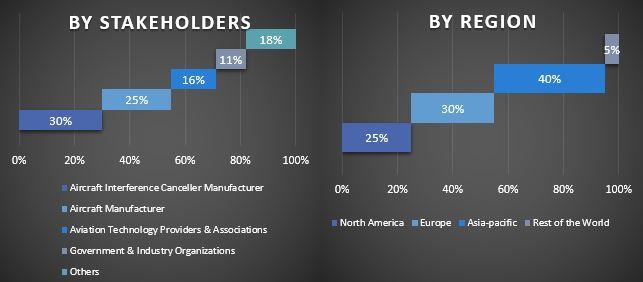
Market Engineering
The data triangulation technique was employed to complete the overall market estimation and to arrive at precise statistical numbers for each segment and sub-segment of the Global Aviation Interference Cancellation market. Data was split into several segments and sub-segments after studying various parameters and trends in the type of signal canceller and by type of aircraft in the Global Aviation Interference Cancellation market.
The main objective of the Global Aviation Interference Cancellation Market Study
The current & future market trends of the Global Aviation Interference Cancellation market were pinpointed in the study. Investors can gain strategic insights to base their discretion for investments on the qualitative and quantitative analysis performed in the study. Current and future market trends determined the overall attractiveness of the market at a regional level, providing a platform for the industrial participant to exploit the untapped market to benefit from a first-mover advantage. Other quantitative goals of the studies include:
- Analyze the current and forecast market size of the Global Aviation Interference Cancellation market in terms of value (USD). Also, analyze the current and forecast market size of different segments and sub-segments.
- Segments in the study include areas of type of signal canceller and by type of aircraft.
- Define and analyze the regulatory framework for the Global Aviation Interference Cancellation
- Analyze the value chain involved with the presence of various intermediaries, along with analyzing customer and competitor behaviors of the industry.
- Analyze the current and forecast market size of the Global Aviation Interference Cancellation market for the major regions.
- Major countries of regions studied in the report include North America (The US, Canada, and Rest of North America), Europe (The UK, France, Germany, Russia, Rest of Europe), Asia-pacific (China, Japan, India, Rest of the Asia-pacific), Rest of the World
- Company profiles of the Global Aviation Interference Cancellation market and the growth strategies adopted by the market players to sustain in the fast-growing market.
- Deep dive regional level analysis of the industry
Frequently Asked Questions FAQs
Q1: What is the current market size and growth potential of the Global Aviation Interference Cancellation market?
Q2: What are the driving factors for the growth of the Global Aviation Interference Cancellation market?
Q3: Which segment has the largest share of the Global Aviation Interference Cancellation market by type of signal canceller?
Q4: Which region will dominate the Global Aviation Interference Cancellation market?
Related Reports
Customers who bought this item also bought










